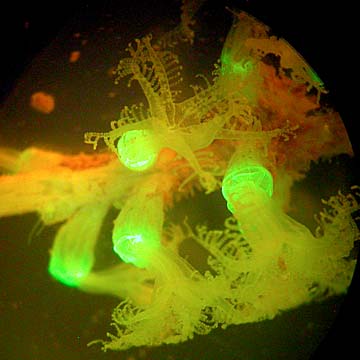
COURTESY PHOTO BY SAM KAHNG
Snowflake coral, an invasive species, is killing black coral trees off Maui. A photo of the invader under blue light shows its fluorescent green proteins.
Alien coral
threatens
isle watersA Caribbean species is smothering
native black coral, which is
a $30 million industry here
A beautiful but deadly alien coral has exploded in abundance and is spreading in the Au Au Channel between Maui and Lanai, according to a University of Hawaii oceanographer.
Carijoa riisei, known as snowflake coral because of its white polyps, is killing black coral colonies and invading barren areas on the ocean floor, said Sam Kahng.
Invasive coral threat update
Sam Kahng, a University of Hawaii graduate student in oceanography, will give a presentation on the alien snowflake coral, Carijoa riisei, and other invasive marine invertebrates from 6:30 to 7:30 p.m. Feb. 26 in the Hanauma Bay theater as part of the Hanauma Bay Educational Lecture Series. The public is invited.
"I think of early winter on the prairie," Kahng said. "You see scrubs coming up."
Kahng surveyed a site known as Keyhole Pinnacles in December on the Hawaii Undersea Research Laboratory's Pisces V submarine.
Kahng's investigation was a follow-up to explorations of the area in 2001 by Richard Grigg, a UH oceanographer and coral reef specialist.
A graduate student in oceanography, Kahng worked with Grigg on the Sea Grant-funded study, which showed snowflake coral had created "a virtual graveyard" in the Maui black coral bed.
"The discovery was pretty shocking," said Grigg, who first observed snowflake coral in 1990. "We didn't expect to see anything like this."
Grigg has retired, though still works part time, and turned the project over to Kahng.
Kahng said Grigg's findings raised questions about the extent of the infestation, the ecological impact and what can be done to manage the potential threat to the state's $30 million black coral industry.
Kahng's observations confirm that the alien coral is killing black corals, not just settling on dead trees, he said. "The number of large dead trees far outnumbered the healthy."
The invasive species also is reaching higher into the water column and replacing Leptoseris, a coral that forms large plates, Kahng said.
Carijoa likes shaded areas with ledges and ridges of three-dimensional features in shallow water but explodes into the open at 180 to 200 feet or deeper, he said.
Although the "killing zone" is below scuba-diving depths, Kahng said the deeper black coral population is believed to be an important source of larvae seeding the shallower populations subject to harvesting.
Patches of snowflake coral were seen in or around all black coral colonies, and several stands of large dead black coral colonies were smothered, including a large area at a depth of 300 feet, he said.
"It has not yet reached its full potential," Kahng said.
A hull-fouling organism, snowflake coral likely arrived in Hawaii from the Caribbean on the bottom of boats or in the ballast water of ships, spreading from harbor to harbor, the oceanographers said. It was first discovered in Pearl Harbor in 1972.
It is one of few soft corals in Hawaii and grows extremely quickly, about half an inch a week, Grigg said. It is also extremely prolific, with as many as 100 eggs in a single polyp, he said.
Kahng said a lot of small colonies are just starting up. "It appears that it is still spreading in terms of more colonies, and also it's growing higher as well. So, it's not a real good sign."
He said the invading coral creates structure as shelter for fish, which is good. But it is very competitive, feeding on zooplankton, which small fish eat, he said.
"So we have a change not only in cover (on the ocean floor), but we potentially have an ecological impact. Carijoa essentially are thousands or millions of little mouths that are straining the water column for zooplankton."
Hawaii has 287 alien marine invertebrate species, Kahng said. Of four considered pests in coral reef communities, snowflake coral is the most invasive and economically harmful, he said.
"It's another source of competition," he said, "another source of mortality that wasn't here 30, 40 or 50 years ago. Probably 80 percent of what we saw was dead coral."
Grigg said he does not think the invasive coral will wipe out black coral beds, "but it diminishes the amount available and it may diminish recruitment (of new coral). A new balance may be struck unless there is a way of controlling it."
Kahng said growth of new coral appears plentiful, with many juvenile black coral colonies 14 to 16 inches high. In most cases, he said, the healthy juvenile black coral trees were scattered in a forest of large, dead, smothered black coral trees 3 to 8 feet high.
Grigg said he found in his 2001 dives that the black coral population is being squeezed by the alien coral and commercial harvesting. He advocates increasing the harvesting size limit to 4 feet from 3 feet to protect growth of smaller trees.
